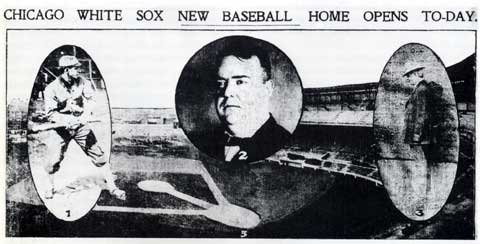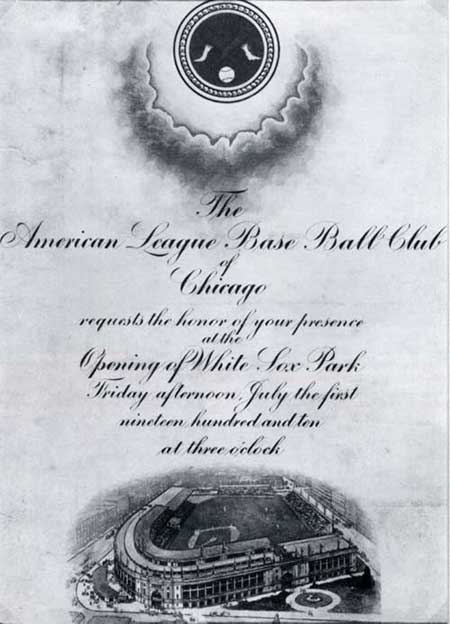
Davis, is submitted his first sketch of the park on October 6, 1909. It was to be built with common red-pressed brick along the exterior walls. (The s initial „C” would be added during a 1927 renovation.) The outfield pavilions were single i and detached from the two-tiered grand- that ringed the park from right to left.
For his media friends Comiskey set aside ten rows of elevated seats in the upper deck behind the rail. This served as the press box for the next thirty- years. The notable feature of Comiskey Park was the sheer massiveness of the playing The original dimensions were 363 feet the foul lines and 420 feet to dead center The park dictated the „Chicago” style of play years to come. The spacious contours d the White Sox pitchers by making home runs very hard to come by. Comiskey believed le best baseball game was low scoring and dominated by pitchers and fielders.

The Chicago Daily News chronicled the “ The Gala Day for Fandom “ when the park opened on July1,1910.CHS Library.
Davis drew much inspiration for his Comiskey Park from Shibe Park in Philadelphia, was built in the beaux-arts style. It featured a lovely French renaissance dome on the exterior roof behind the plate and large arching windows that Davis later adopted for Comiskey Park. Shibe would have fit in well with Daniel Burnham’s vision for Chicago: a „City Beautiful” laced with public parks and grand buildings designed in classical or historical styles. Davis recommended adaptation of the cantilevered grandstand—free from bothersome obstructing posts—at an additional cost of $350,000. Comiskey rejected this idea for reasons that are unclear today; his „penny wise, dollar foolish” attitude may be the best explanation. Instead, he ordered construction to proceed with vertical posts and without any classical ornamentation. Sadly, the fine, graceful lines of Shibe Park were to be absent in Comiskey Park. Because of the restrictions Charles Comiskey placed on Davis, the final design emerged as uninspired contemporary architecture. Comiskey Park would be a functional baseball plant dropped into a working-class neighborhood and surrounded by factory buildings.
An inherently superstitious man, Charles Comiskey sought permission from the league during the winter meetings to reschedule the grand opening of his new ballpark from Friday, July 1, to Thursday, June 30, because of an Irish superstition about unlucky Fridays. The request was denied. Comiskey must have had many reservations as misfortune and bad luck impeded the progress of construction. An unexpected strike of structural steel workers delayed construction for five full weeks. The first consignment of steel beams did not arrive until March 1910, and Comiskey allegedly paid off officials in the construction industry for scab workers to complete the job in time. The infield sod was planted on June 17, the same day that building department inspectors declared it „as safe as the Rock of Gibraltar.”
The day before the gala opener a forty-six-year- old laborer named Frank McDermott died after falling off the top of the grandstand. Comiskey’s superstitions must have been troubling him. On the grand day, a score of dignitaries joined 28,000 fans to watch the Sox quietly lose to the St. Louis Browns, even with Ed Walsh on the mound for Chicago. Within the next three days, four Sox regulars were felled by injury. Speculation arose that the park was cursed. And in some ways maybe it was. The next decade brought success and then scandal; Comiskey won two pennants only to see his team decimated by the 1919 Black Sox affair.
Source:
CHICAGO HISTORY
The Magazine of The Chicago Historical Society
Summer 1989,Volume XVIII, Number2
YESTERDAY’S City by Richard Lindberg
Part I

A rendering of Davis’s original design on the official invitation to opening day shows the embellishments and fountains sadly eliminated from the final structure. Pat Quinn.
